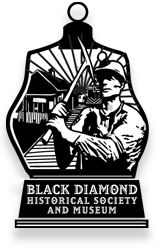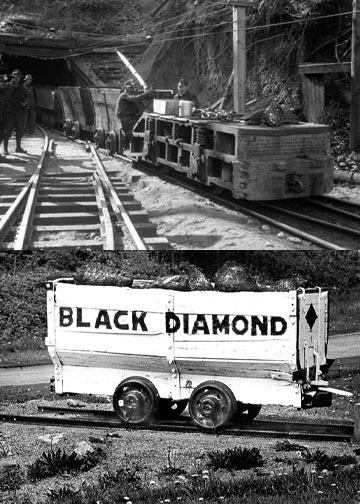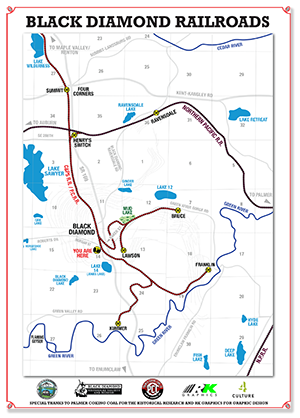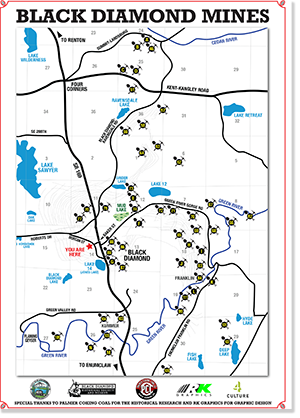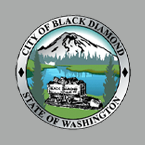Beginning in the 1880s Black Diamond was a rural coal mining area, developed by the Black Diamond Coal Mining Company of California, which owned and operated the mine. The original residents were largely composed of former workers, from the company’s previous coal mining operation in Nortonville, California, which primarily sold coal to the thriving new metropolis of San Francisco. A combination of low quality coal from the Nortonville mines, water intrusion into the workings there, and the discovery and economical transport of higher-quality Washington coal to San Francisco spelled the demise of Nortonville in the early 1880s.The town was home to around 3,500 people by the early 1900s, many of them European immigrants; most of the working men were involved in producing coal. This coal was transported to Seattle via the Pacific Coast Coal train. Before 1911, the miners were affiliated with the United Mine Workers of America (UMWA), but by March 1911 had left en masse to join the Industrial Workers of the World (IWW).
After World War I, the town shut down the mine as it was no longer viable and oil had consumed the coal business. However, a second mining boom did spur growth in the town in the early 1930s on the strength of multiple mining operations promoted by the Morris brothers through the Palmer Coking Coal Company. Underground mining continued until the Rogers No. 3 closed in 1975.
The Black Diamond Museum is the former train depot, which served the Columbia & Puget Sound Railway 1884–1916 and the Pacific Coast Railway 1916–1951. Regular passenger service ended in 1925, but a train still brought men to the mine until 1931, and trains continued to haul coal and freight into the 1940s.
In the 1990s the City created its first Master Planned Development (MPD). The 2000 census was a population of 3,970. The 2023 population is 5,839 with continued growth expected based on growth of both residential homes and businesses.
Black Diamond History
1880. Black Diamond’s name came from the Black Diamond Coal Mining Company of Nortonville, California. The mine at Nortonville had low-grade coal but there was a great demand from nearby San Francisco. The Company heard of discoveries of good coal in the Washington territory. Victor Tull was sent here in 1880 and he discovered coal just above the Jones Lake (or Lake 14) [Note: Some historical records called it Lake Jones]. This lake is just east of the Black Diamond Bakery and adjacent to Hwy 169. Tull mined about 880 pounds of coal and sent it for testing, which found the coal to be excellent.
1882. Morgan Morgans, Superintendent of the Black Diamond Coal Mining Company, and P.B. Cornwall, President, came to Black Diamond for further investigation. They not only saw an excellent coal seam, but an abundance of timber for building mine facilities and homes. They returned with a crew of men and one woman, Clarissa Davies. The log cabin they built was given to Davies and a tent village was constructed for the men (located where this depot is now).
1882. There was no transportation at the time; everything was done with horses and mules. Morgans and Cornwall convinced the Columbia & Puget Sound (C&PS) to build a railroad from Renton to Black Diamond, which took two years to complete. The C&PS was owned by Henry Villard whose Oregon Improvement Company (OIC), an arm of the Northern Pacific also had an interest in the rail line as it would serve its recently established town of Franklin.
Families then began the move from Nortonville to Black Diamond. Most of the original families were first-generation Americans of Welsh or Italian descent. The Welsh came from a long line of coal miners in their native land of Wales. Because of this, a hierarchy existed whereby the Welshmen executed tasks that required more skill and were better paid.
1884. The first train arrived in Black Diamond in December 1884.
1885. And so it began with coal shipments from both Black Diamond and the nearby town of Franklin further down the rails. The Green River district became “King” of the coal industry. By the turn of the century, there were nearly 3,500 people of many nationalities living in Black Diamond and perhaps 1,000 more in Franklin. The town was booming with hotels, businesses, social activities and many mines.
1896. Pacific Coast Company acquired Franklin out of the receivership of the Oregon Improvement Company. The acquisition included the Columbia & Puget Sound Railroad which served both Black Diamond and Franklin. Pacific Coast was a conglomerate which included a coal arm, Pacific Coast Coal Co., a railroad, C&PS, a shipping firm, Pacific Coast Steamship Co., and eventually even cement, Pacific Coast Cement Co.
1898. Pacific Coast Company acquired the coal mines of Eugene Lawson which were located just east of Black Diamond. Six years later, Lawson helped broker the deal by which Pacific Coast purchased the mine and town.
1904. The Pacific Coast Company bought the Black Diamond Coal Company and the town. The Company owned practically everything. Families could buy houses, but the company leased them the land on which the houses stood for one dollar a month. They originally declared that only one church was necessary and a Congregational Church was built to accommodate all faiths. Different services were held each Sunday on a rotational basis, but everyone attended all of them. Later the town would have a company store, where workers could buy goods with the cost deducted from their paychecks.
Working in the Mines: Early miners digging the coal were paid by the ton; others were paid by the day or hourly. Miners typically worked 10-hour days, six days a week. Work in the mines was harsh and dangerous as the Black Diamond mines were on steeply pitching seams. Coal seams in the region had been pushed up and contorted by the rise and formation of the Cascade Mountains. The slopes were dug at the steep angles necessary to follow the seam. Coal cars were hoisted up and down the slope by thick steel cables.
1907. At first, the miners had no union but were actually paid more than most union workers in other parts of the country. As time went on working conditions and wages became an issue. The miners organized Local 6481 of the United Mine Workers of America. When the Union started meeting near the train depot, the company would not allow them to congregate on company property. The workers walked outside of the town limits and one of them jumped on a stump to speak to the men. This stump, known as “Union Stump” would serve as their meeting location for many years. It has been encased in concrete and still stands today.
1910. 16 men perished in an explosion at the Lawson mine. 5 are entombed in the mine; 8 are buried in a common grave at the Black Diamond Cemetery; and only 2 headstones do not include all the names.
1914. World War I created a greater demand for coal. Wages had been slowly rising since the union organized and were by then up to $8 a day.
1918. The end of World War I caused coal prices to fall sharply. The company thought wages should fall too. They wanted the miners to go back to $7 a day, causing an outrage. The company labeled the most vocal dissenters “agitators,” and fired them. The union insisted that they be rehired, but they were not. Along with this, the company refused to give current workers a new contract and started bringing in non-union labor.
1921. The miners threatened to strike, but the company locked them out first. Even though some folks owned their homes, the company still owned the land. The dollar-a-month lease was taken away, and families were told to either sell their homes or move them. The Company actually bought homes at a fair price, but many long-time residents who were now out of a job were also faced with nowhere to live.
The Union stepped in and built 200 new homes on land donated by Tim Morgan (no relation to Morgan Morgans). This new settlement, to the west of Black Diamond, became known as Morgansville. The houses were built quickly, with little insulation or attention to detail, yet some are still standing to this day.
Some of the strikers found work in local mills, but others moved away. Within a few years, some men begrudgingly went back to work in the mines, but many were blackballed for life and their mining careers were finished forever.
1932. The mines remained non-union until President Roosevelt was elected. His Depression-era New Deal economic policies, which United Mine Workers president John L. Lewis helped to write, brought strength to many unions nationwide. The coal miners in Black Diamond re-established their union in 1933, but it was too late. Coal was increasingly being displaced by more convenient fuel oil from California and electricity from hydroelectric dams built by the Federal government.
1933. At the depth of the Great Depression, a company was formed in the nearby town of Durham in August. Its name was Palmer Coking Coal Co. and its founders had established themselves a dozen years earlier as Morris Brothers Coal Mining Co.
1937. Palmer Coking Coal (Palmer) purchased the assets of Morris Brothers as the two firms became one. They were soon to venture closer to Black Diamond when they opened underground mining operation in Danville on what came to be known as the Landsburg coal seams.
1938. The demand for coal continued to decline, so Pacific Coast Company disbanded Black Diamond as a company town. The town was surveyed and miners could purchase the homes they lived in. Power lines were given to the power company and roads were deeded to the county. The company also began leasing some of their mines to operators like Bill Strain.
1940s. World War II brought new demand for coal and Pacific Coast reopened some of their own mines and leased out others.
1946. Palmer leased 43-acres from Pacific Coast including their coal washing facilities and coal bunkers at Mine 11. That lease turned into a sale which closed in 1950.
1953. Palmer Coking Coal Co. had been successfully operating mines at Landsburg so negotiated with Pacific Coast Co. to purchase most of the assets of the Pacific Coast Coal Company. A contract was signed in June 1953 by which Palmer would acquire over 8,000 acres of property and mineral rights in King County, including Pacific Coast’s Newcastle, Black Diamond, and Franklin properties and much surrounding acreage.
1958. Palmer’s purchase of the Pacific Coast properties was completed, though 2,000 of the 8,000 acres was conveyed to Weyerhaeuser by Palmer to help finance the remainder.
1950 and 60s. Palmer operates multiple underground coal mines including Danville, Landsburg, Rogers No. 1, 2, and 3, Kummer, Franklin No. 10, No. 12, and the Fulton seam.
1959. Black Diamond was incorporated as a city.
1975. Palmer closes the last underground coal mine in the state of Washington, the Rogers No. 3 near Ravensdale, adjacent to Black Diamond. Surface mining and reclamation work continued until
1986. Over their 53-year period, Palmer mined and sold nearly 2.4 million tons of coal.
1985. The John Henry No. 1 surface coal mine is started by a new company of Palmer owners adopting the old name of Pacific Coast Coal Company. The mine is operated through the early 2000s; then operations are suspended.
In addition to visiting Black Diamond, it is a quick trip to visit other local historic areas and surrounding towns including Bayne, Cumberland, Kanasket, Kummer, Landsburg, Ravensdale and more.
Get Railroad & Mines Maps
Railroads Map
Our new Railroads Map outlines the routes, railroad companies, and provides a detailed timeline from 1873 – 1991. Grab the map and start exploring the history and impact railroads had on the coal industry, businesses and families living in Black Diamond, WA.
Mines Map
Stop by the museum or download our new Black Diamond WA Mines Map. This detailed map features Mines Pre-1945 and Post 1945. Over 45 mines scattered Black Diamond providing families with work, business with customers and the country with coal.
